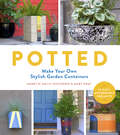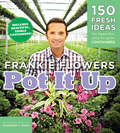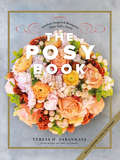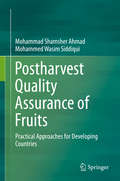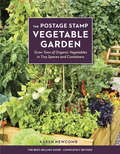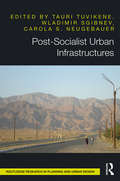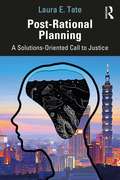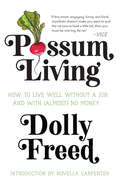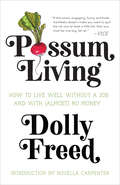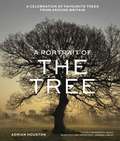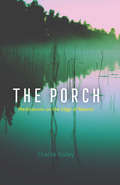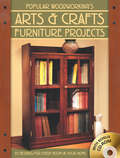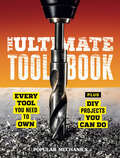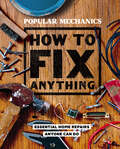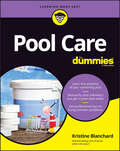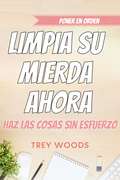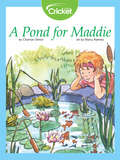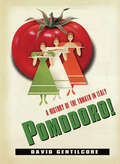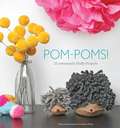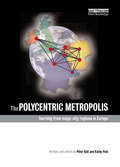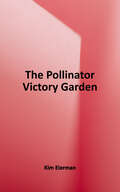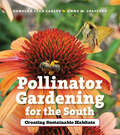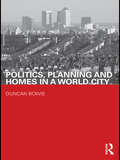- Table View
- List View
Potted: Make Your Own Stylish Garden Containers
by Annette Goliti Gutierrez Mary GrayHand-made style for outdoor living Outdoor style often comes at a high price, but it doesn’t have to. This lushly designed guide empowers you to create your own show-stopping containers made from everyday materials such as concrete, plastic, metal, terracotta, rope, driftwood, and fabric. The 23 step-by-step projects are affordable, made from accessible materials, and most importantly, gorgeous. They include new spins on old favorites, like the cinderblock garden made popular by design blogs or hanging planters made from enamelware bowls, along with never-before-seen ideas like a chimney flue planter and wall planters made from paint cans. Packed with color photographs and simple instruction, Potted is for anyone who wants to turn an outdoor space into a stylish oasis.
Pot It Up: 150 Fresh Ideas for Beautiful, Easy-to-Grow Containers
by Frankie FlowersContainers are a gardener’s best friend—they make it easy and fun to bring a burst of life and colour to your porch, balcony or front step. But so many of us get stuck in a rut. Frankie Flowers is here with 150 inspiring, beautiful and sometimes surprising container ideas to get your juices flowing. Each plays with Frankie’s signature technique of using a thriller, a filler and a spiller to make sure your pot will have maximum impact. Frankie gives you the breakdown on which plants he’s used, and to which conditions they’re best suited. And if you’re feeling a little peckish, Frankie’s even got some delicious edibles for you to throw into the mix. With Frankie’s step-by-step instructions, and the don’t-sweat-it attitude readers came to love in his first bestseller, Get Growing, Frankie’s Pot It Up will have the whole country going to pot—in the best way possible!
The Posy Book: Garden-inspired Bouquets That Tell A Story
by Teresa H. Sabankaya“Like a favorite recipe, a posy is meant to be savored and shared. Try it yourself, and … welcome a bit of floral enchantment into your life.” —Amy Stewart, author of The Drunken Botanist Inspired by the Victorian-era language of flowers, a posy is a small, round bouquet of flowers, herbs, and plants meant to convey a message, such as dahlias for gratitude, sunflowers for adoration, or thyme for bravery. These floral poems have become Teresa Sabankaya’s signature. Brides want them for their weddings, but a posy is a lovely gift any time of year, and one that readers can easily put together from their garden or with blooms from their local florist. In The Posy Book, Sabankaya shares step-by-step instructions, floral recipes for more than 20 posies, and ideas for seasonal variations. A modern floral dictionary, with 12 original paintings by celebrated illustrator Maryjo Koch, will help readers craft their own posies filled with personal meaning.
Postharvest Quality Assurance of Fruits
by Mohammad Shamsher Ahmad Mohammed Wasim SiddiquiThis book presents a comprehensive study of the handling of fresh fruits in the developing world from harvesting to the shelf. With annual losses ranging from 30-40% due to lack of knowledge on proper handling practices and value addition, this book's information on postharvest handling and quality testing is crucial for reducing these losses and improving the quality and safety of fresh fruits in these areas. With its added focus on marketing and organized retail aspects, Postharvest Quality Assurance of Fruits: Practical Approaches for Developing Countries covers the entire range of fruit handling, from transportation and packaging to quality assessment and commercial preparation. In presenting a fully comprehensive outline of the factors affecting postharvest quality and marketability of fruits, this work lays the foundation for understanding the proper storage, transportation and packaging methods to prevent losses and increase quality. With its study of prevailing marketing systems, supply chains and retail methods, the book presents the complete picture for the postharvest handling of fruits in the developing world.
The Postage Stamp Vegetable Garden
by Karen NewcombThis classic gardening bestseller (over 500,000 copies sold) uses ecologically friendly, intensive biodynamic methods to produce large amounts of vegetables in very tiny spaces. Revised for an all new generation of gardeners, the 40th anniversary edition includes brand new information on the variety of heirloom vegetables available today and how to grow them the postage stamp way. To accommodate today's lifestyles, a garden needs to fit easily into a very small plot, take as little time as possible to maintain, require a minimum amount of water, and still produce prolifically. That's exactly what a postage stamp garden does. Postage stamp gardens are as little as 4 by 4 feet, and, after the initial soil preparation, they require very little extra work to produce a tremendous amount of vegetables--for instance, a 5-by-5-foot bed will produce a minimum of 200 pounds of vegetables. When first published 40 years ago, the postage stamp techniques, including closely planted beds rather than rows, vines and trailing plants grown vertically to free up space, and intercropping, were groundbreaking. Now, in an ever busier world, the postage stamp intensive gardening method continues to be invaluable for gardeners who wish to weed, water, and work a whole lot less yet produce so much more.From the Trade Paperback edition.
Post-Socialist Urban Infrastructures
by Tauri Tuvikene Wladimir Sgibnev Carola S. NeugebauerPost-Socialist Urban Infrastructures critically elaborates on often forgotten, but some of the most essential, aspects of contemporary urban life, namely infrastructures, and links them to a discussion of post-socialist transformation. As the skeletons of cities, infrastructures capture the ways in which urban environments are assembled and urban lives unfold. Focusing on post-socialist cities, marked by neoliberalisation, polarisation and hybridity, this book offers new and enriching perspectives on urban infrastructures by centering on the often marginalised aspects of urban research—transport, green spaces, and water and heating provision. Featuring cases from West and East alike, the book covers examples from Azerbaijan, Bulgaria, Serbia, Croatia, Germany, Russia, Georgia, Lithuania, Poland, the Czech Republic, Tajikistan, and India. It provides original insights into the infrastructural back end of post-socialist cities for scholars, planners and activists interested in urban geography, cultural and social anthropology, and urban studies.
Post-Rational Planning: A Solutions-Oriented Call to Justice
by Laura E. TatePost-Rational Planning confronts today’s threats to truth, particularly after recent news events that present alternative facts and media smear campaigns, often described as post-truth politics. At the same time, it appreciates critical tensions: between rationality (prized by planners and other policy professionals) and desires for positive, socially just outcomes. Rather than abandoning quests for truth, this book provides planners, policy professionals, and students with tools for better responding to debates over truth. Post-Rational Planning examines planners’ unease with emotion and politics, advocating for more scholarship and practice capable of unpacking uses of rhetoric and framing to support or counter key planning decisions impacting social justice. This includes learning from recent works engaging with rhetoric, narrative construction, and framing in planning, while introducing other valuable concepts from disciplines like psychology, including confirmation bias; identity-protective cognition; from marketing and adult education. Each chapter sheds new light on a specific topic requiring a response through post-rational practice. It starts with recent research findings, then demonstrates them with case examples, enabling their use in classroom and practice settings. Each chapter ends by summarizing key lessons in "Take-aways for Practice," better enabling readers of all levels to synthesize and use key ideas.
Possum Living (Almost) No Money: How To Live Well Without A Job And With (almost) No Money
by Dolly FreedAfter being out of print for decades, Possum Living: How to Live Well Without a Job and (Almost) No Money is being reissued with an afterword by an older and wiser Dolly Freed. In the late seventies, at the age of eighteen and with a seventh-grade education, Dolly Freed wrote Possum Livingabout the five years she and her father lived off the land on a half-acre lot outside of Philadelphia. At the time of its publication in 1978, Possum Living became an instant classic, known for its plucky narration and no-nonsense practical advice on how to quit the rat race and live frugally. In her delightful, straightforward, and irreverent style, Freed guides readers on how to buy and maintain a home, dress well, cope with the law, stay healthy, save money, and be lazy, proud, miserly, and honest, all while enjoying leisure and keeping up a middle-class façade. Thirty years later, Freed's philosophy is world-renowned andPossum Living remains as fascinating, inspirational, and pertinent as it was upon its original publication. This updated edition includes new reflections, insights, and life lessons from an older and wiser Dolly Freed, whose knowledge of how to live like a possum has given her financial security and the confidence to try new ventures.
Possum Living: How to Live Well Without a Job and with (Almost) No Money (Revised Edition)
by Dolly Freed David GatesAfter being out of print for decades, Possum Living: How to Live Well Without a Job and (Almost) No Money is being reissued with an afterword by an older and wiser Dolly Freed. In the late seventies, at the age of eighteen and with a seventh-grade education, Dolly Freed wrote Possum Livingabout the five years she and her father lived off the land on a half-acre lot outside of Philadelphia. At the time of its publication in 1978, Possum Living became an instant classic, known for its plucky narration and no-nonsense practical advice on how to quit the rat race and live frugally. In her delightful, straightforward, and irreverent style, Freed guides readers on how to buy and maintain a home, dress well, cope with the law, stay healthy, save money, and be lazy, proud, miserly, and honest, all while enjoying leisure and keeping up a middle-class façade. Thirty years later, Freed's philosophy is world-renowned andPossum Living remains as fascinating, inspirational, and pertinent as it was upon its original publication. This updated edition includes new reflections, insights, and life lessons from an older and wiser Dolly Freed, whose knowledge of how to live like a possum has given her financial security and the confidence to try new ventures.
A Portrait of the Tree: A celebration of favourite trees from around Britain
by Adrian HoustonA stunning collection of portraits of favourite trees from around Britain by photographer Adrian Houston.---'This is a wonderful book: beautiful and important' - Joanna Lumley'A must-read for all conservationists, environmentalists and nature lovers' - Sir Richard Branson'Adrian's stunning photographs capture the majesty of these iconic trees.' - Geraint Richards, Chair of Action Oak---A Portrait of the Tree is a repository of memories, and a testament to the British landscape. Trees are revealed as religious signifiers, historical landmarks, national emblems.Sparked by a simple question: 'What is your favourite tree?', photographer Adrian Houston discovered a wealth of fascinating stories enmeshed with these giants of the natural world - some of miraculous survival, others of sheltering royalty, or witnessing history, or simply of personal grief and renewal. Adrian photographed each nominated tree looking utterly glorious: spotlit by night, bathed in morning sunshine, wreathed in delicate mist or blazing with autumn colour. From the cedars of Highclere Castle to the plane trees of London, ancient pine woods of the Scottish Highlands to veteran oaks that have stood witness to time; from native stalwarts such as the monumental beech to endangered giant redwoods. This stunning celebration bears witness to the might and majesty of the lungs of the earth - the tree. Includes: Joanna Lumley, Tony Kirkham, Dr George McGavin, Antony Gormley, Jasper Conran, Alice Temperley, Alan Titchmarsh, Sir Richard Carew Pole, the Reverend Lucy Winkett
Portfolios for Interior Designers
by Maureen MittonThe complete guide to portfolio development for interior designersIt's a widely known fact that interior designers need a strong visual presence in the form of a well-crafted, professional-looking portfolio. Surprisingly, however, many interior designers aren't equipped with the expertise required to organize and unify their work in a fashion that optimally conveys their talents and skills.Portfolios for Interior Designers helps demystify the process by guiding the reader toward mastery in assembling a winning portfolio. It delivers essential step-by-step instruction presented in a manner that shows interior designers how to properly and effectively display their designs. This book also includes:Color and black-and-white illustrations showing portfolio elements and optionsGraphic design concepts necessary for portfolio developmentSpecific information for the design of digital portfoliosSupplemental teaching resources that direct readers to a companion Web siteUseful tips on the ways that popular graphics software applications can be best implemented for certain portfolio elementsSamples of cover letters and resumes, along with discussion of job search proceduresWith the aid of real-world examples, Portfolios for Interior Designers examines how a portfolio can be used as an effective tool for communicating with clients and other professionals. A much-needed guide, this book eliminates the uncertainty surrounding portfolio development so that interior designers can showcase their abilities success-fully--and land the next job.
The Porch: Meditations on the Edge of Nature
by Charlie HaileyCome with us for a moment out onto the porch. Just like that, we’ve entered another world without leaving home. In this liminal space, an endless array of absorbing philosophical questions arises: What does it mean to be in a place? How does one place teach us about the world and ourselves? What do we—and the things we’ve built—mean in this world? In a time when reflections on the nature of society and individual endurance are so paramount, Charlie Hailey’s latest book is both a mental tonic and a welcome provocation. Solidly grounded in ideas, ecology, and architecture, The Porch takes us on a journey along the edges of nature where the outside comes in, hosts meet guests, and imagination runs wild. Hailey writes from a modest porch on the Homosassa River in Florida. He sleeps there, studies the tides, listens for osprey and manatee, welcomes shipwrecked visitors, watches shadows on its screens, reckons with climate change, and reflects on his own acclimation to his environment. The profound connections he unearths anchor an armchair exploration of past porches and those of the future, moving from ancient Greece to contemporary Sweden, from the White House roof to the Anthropocene home. In his ruminations, he links up with other porch dwellers including environmentalist Rachel Carson, poet Wendell Berry, writers Eudora Welty and Zora Neale Hurston, philosopher John Dewey, architect Louis Kahn, and photographer Paul Strand. As close as architecture can bring us to nature, the porch is where we can learn to contemplate anew our evolving place in a changing world—a space we need now more than ever. Timeless and timely, Hailey’s book is a dreamy yet deeply passionate meditation on the joy and gravity of sitting on the porch.
The Porch: Meditations on the Edge of Nature
by Charlie HaileyCome with us for a moment out onto the porch. Just like that, we’ve entered another world without leaving home. In this liminal space, an endless array of absorbing philosophical questions arises: What does it mean to be in a place? How does one place teach us about the world and ourselves? What do we—and the things we’ve built—mean in this world? In a time when reflections on the nature of society and individual endurance are so paramount, Charlie Hailey’s latest book is both a mental tonic and a welcome provocation. Solidly grounded in ideas, ecology, and architecture, The Porch takes us on a journey along the edges of nature where the outside comes in, hosts meet guests, and imagination runs wild. Hailey writes from a modest porch on the Homosassa River in Florida. He sleeps there, studies the tides, listens for osprey and manatee, welcomes shipwrecked visitors, watches shadows on its screens, reckons with climate change, and reflects on his own acclimation to his environment. The profound connections he unearths anchor an armchair exploration of past porches and those of the future, moving from ancient Greece to contemporary Sweden, from the White House roof to the Anthropocene home. In his ruminations, he links up with other porch dwellers including environmentalist Rachel Carson, poet Wendell Berry, writers Eudora Welty and Zora Neale Hurston, philosopher John Dewey, architect Louis Kahn, and photographer Paul Strand. As close as architecture can bring us to nature, the porch is where we can learn to contemplate anew our evolving place in a changing world—a space we need now more than ever. Timeless and timely, Hailey’s book is a dreamy yet deeply passionate meditation on the joy and gravity of sitting on the porch.
Popular Woodworking's Arts & Crafts Furniture: 25 Designs For Every Room In Your Home
by Popular Woodworking EditorsTimeless Style and Simplicity Simple and beautiful, Arts & Crafts furniture designs offer an excellent learning medium for furniture building. The Arts & Crafts style allows the craftsman to build a quality piece of furniture in a reasonable amount of time while providing a very successful and satisfying experience. This book offers a collection of twenty-five Arts & Crafts furniture projects for every room in your home. Some of the projects are accurate reproductions of the original furniture pieces, while others are loving adaptations of the style. In addition to the projects in the book, we've included a Bonus CD-ROM with ten furniture projects and ten technique articles to provide even more information on construction and finishing. This book represents a collection of projects that the Popular Woodworking staff considers to be some of the most visually appealing pieces of furniture ever created.
Popular Mechanics The Ultimate Tool Book: Every Tool You Need to Own
by Popular MechanicsThis definitive illustrated reference covering 100 hand tools and how to use them is &“an excellent guide for budding DIYers&” (Booklist). This tool—or that? Learn how to choose the right one for tackling any home project and completing it quickly, correctly, and efficiently. The editors of Popular Mechanics share their expertise, explaining which tools deserve a prominent spot in your shop and how to keep them in tip-top shape. Divided by type, this must-have guide covers multipurpose and single-purpose tools that cut, tighten, measure, and mark. You&’ll also find tried-and-true suggestions, helpful notes, and simple hacks to make any job easier.
Popular Mechanics: Essential Home Repairs Anyone Can Do
by Popular MechanicsA step-by-step guide to home repairs large and small from Popular Mechanics—the name that&’s &“synonymous with the ultimate in DIY knowledge&” (Booklist, starred review). Got a squeaky floor or a rattling door? Is your grout a color you don&’t recognize anymore? From quick fixes like linking broken chains and patching drywall to more involved projects like replacing a fuel line and bleeding your brakes, Popular Mechanics How to Fix Anything is the handy and reliable go-to guide for the most common household problems—offering a primer on plumbing; unexpected hacks like using a golf tee to fill a stripped screw hole; instructions for tuning up the garage door; and so much more. Throughout the book Roy Berendsohn, Popular Mechanics&’ senior home editor, answers questions about the trickiest fix-its, including how to deal with recurring ceiling cracks or get rid of that stench from the kitchen sink. And because it&’s organized room by room, from basement to bathroom to bedroom, it&’s simple to find the solution you need—so you won&’t have to hire someone else to do the job.
Pool Care For Dummies
by Kristine BlanchardCrystal-clear advice for maintaining a crystal-clear swimming pool Keeping a swimming pool ready for use requires some chemistry know-how, an understanding of how pool mechanics work, and some time spent doing good old-fashioned cleaning work. Pool Care For Dummies offers a reliable, comprehensive resource for building the knowledge that lets you turn pool maintenance into a do-it-yourself task. Written by a certified swimming pool professional who started taking care of pools when she was 5 years old, this book helps you separate the good advice from the bad as you learn to build an upkeep schedule, figure out what chemicals you actually need and which are less-than-magical potions, and fix the common problems that plague all pool owners. With so much trustworthy pool care advice in one place, you can finally cut back on time spent searching for swimming pool advice and more time splashing with your friends and family! Learn how pools work and get the tools you need to keep your pool running Test your water and maintain a safe swimming environment Care for your and balance your above-ground or in-ground pool Know what to do when unexpected problems arisePrivate pool owners who need to know what’s what in the water will love this clear and complete Dummies guide.
Poner en orden: Haz las cosas sin esfuerzo
by Trey WoodsProbablemente haya visto muchos programas en la televisión sobre cómo las personas acumulan varios artículos diferentes, ya sea porque les encanta comprar o porque han recopilado muchos artículos a lo largo del tiempo y no pueden soportar separarse de ellos. Llega al punto en que sus armarios e incluso sus casas enteras se llenan por completo, y es casi imposible moverse. Es posible que conozca a personas así en su propia vida, o tal vez, sea una de estas personas. Si está leyendo este libro, asumiré que el desorden en su espacio se está apoderando de su vida. Quizás se pregunte cuál es el problema. Entonces, ¿qué pasa si yo, o cualquier otra persona, recolectamos muchos artículos? Bueno, las cosas son tuyas y tienes todo el derecho a hacer lo que quieras con ellas. Sin embargo, lo que quiero abordar son los problemas psicológicos que resultan en la acumulación de desorden en su vida, así como los efectos que el mismo desorden tiene en su psique a largo plazo. En este libro aprenderá: ✓ El desorden en tu vida ✓ Por qué tiene desorden ✓ Por qué no reconoce lo que es el desorden ✓ No sabe cuánto tiempo debe conservar algo ✓ Por qué está comprando demasiadas cosas que no necesita ✓ Las consecuencias de demasiado desorden ✓ Romper su relación con "cosas" ✓ Superar el efecto de la dotación ✓ Los beneficios de ordenar ✓ Ordenar es igual a un mayor enfoque y productividad ✓ Ordenar y mejorar la salud ✓ Desafío de limpieza de 6 semanas ¡Y mucho más! Si bien ordenar puede ser muy difícil al principio, también puede ser muy liberador y tener un impacto positivo en su vida en todos los sentidos. En este capítulo, repasaré varias técnicas diferentes para que pueda comenzar a reducir sus artículos personales o reorganizarlos de manera adecuada. De cualquier manera, su hogar y espacio de trabajo se
A Pond for Maddie
by Charnan SimonWhat is the difference between and man-made pond and a natural pond? Maddie learns all about ponds while she and her family bring an artificial pond back to life.
Pomodoro!: A History of the Tomato in Italy (Arts and Traditions of the Table Perspectives on Culinary History)
by David GentilcoreA chronicle of the beloved base ingredient, from its origins, agricultural riches, and controversy to the passion, pride, and nostalgia it inspires today. Over time, the tomato has embodied a range of values and meanings. From its domestication in Central America, it has traveled back and forth across the Atlantic, powering a story of aspiration and growth, agriculture and industry, class and identity, and global transition. In this entertaining, organic history, David Gentilcore recounts the surprising rise of the tomato from its New World origin to its Old World significance. From its inauspicious introduction into Renaissance Europe, the tomato came to dominate Italian cuisine and the food industry over the course of three centuries. Gentilcore explores why elite and peasant cultures took so long to assimilate the tomato into Italian cooking and how it eventually triumphed. He traces the tomato's appearance in medical and agricultural treatises, travel narratives, family recipe books, kitchen accounts, and Italian art, literature, and film. He focuses on Italy's fascination with the tomato, painting a larger portrait of changing trends and habits that began with botanical practices in the sixteenth century and attitudes toward vegetables in the seventeenth and eighteenth centuries, and concluded with the emergence of factory production in the nineteenth. Gentilcore continues with the transformation of the tomato into a national symbol during the years of Italian immigration and Fascism and examines the planetary success of the "Italian" tomato today. &“Those with an interest in tomatoes, Italian life, or just cultural history in general may find this both enlightening and entertaining.&” —Diane Leach, PopMatters
Pom-Poms!: 25 Awesomely Fluffy Projects
by Sarah Goldschadt Lexi Walters WrightWhether they're perking up your clothes, brightening your home decor, or bringing a rainbow of color to your next party, pom-poms are perfect wherever they pop up. Each project in this book has oh-so-simple instructions and photographs that'll have you whipping up homemade tufts in all kinds of eye-catching patterns, from speckles to stripes to polka-dots. And don't worry about running out of yarn. You'll learn how to put a new spin on poms with a host of fun materials like tissue paper, tinsel, coffee filters, and cupcake wrappers. With 25 fresh and fancy takes on a classic, Pom-Poms! will give crafters of all ages a reason to cheer.
The Polycentric Metropolis: Learning from Mega-City Regions in Europe
by Peter Hall Kathy PainA new 21st century urban phenomenon is emerging: the networked polycentric mega-city region. Developed around one or more cities of global status, it is characterized by a cluster of cities and towns, physically separate but intensively networked in a complex spatial division of labour. This book describes and analyses eight such regions in North West Europe. For the first time, this work shows how businesses interrelate and communicate in geographical space - within each region, between them, and with the wider world. It goes on to demonstrate the profound consequences for spatial planning and regional development in Europe - and, by implication, other similar urban regions of the world. The Polycentric Metropolis introduces the concept of a mega-city region, analyses its characteristics, examines the issues surrounding regional identities, and discusses policy ramifications and outcomes for infrastructure, transport systems and regulation. Packed with high quality maps, case study data and written in a clear style by highly experienced authors, this will be an insightful and significant analysis suitable for professionals in urban planning and policy, environmental consultancies, business and investment communities, technical libraries, and students in urban studies, geography, economics and town/spatial planning.
The Pollinator Victory Garden: Win the War on Pollinator Decline with Ecological Gardening: How to Attract and Support Bees, Beetles, Butterflies, Bats, and Other Pollinators
by Kim EiermanThis book explains about how you can create a beautiful landscape that attracts and supports many different species of pollinators.
Pollinator Gardening for the South: Creating Sustainable Habitats
by Danesha Seth Carley Anne M. SpaffordThis step-by-step guide will answer all of your questions about how to create beautiful gardens designed to welcome beneficial pollinators across the South. Combining up-to-date scientific information with artful design strategies, Danesha Seth Carley and Anne M. Spafford teach gardeners of all levels to plan, plant, and maintain successful pollinator gardens at home and in shared community sites. Everyday gardeners, along with farmers, scientists, and policy makers, share serious concerns about ongoing declines in bee and other pollinator populations, and here Spafford and Carley deliver great news: every thoughtfully designed garden, no matter how small, can play a huge role in providing the habitat, nourishment, and nesting places so needed by pollinators. This book explains all you need to be a pollinator champion.*Covers USDA hardiness zones 6, 7, 8, and 9, including twelve southern states*Explains what makes pollinators happy—bees, for sure, and many others, great and small*Brings science and art together in gardens of all types, including urban, food, container, community, school, and large-scale gardens*Provides step-by-step instructions for choosing locations, preparing soil and garden beds, selecting the best plants, considering seasonality in your garden design, managing your garden throughout the year, and much more*Richly illustrated with photographs, design plans, and handy charts and lists
Politics, Planning and Homes in a World City (Housing, Planning and Design Series)
by Duncan BowieThis is an insightful study of spatial planning and housing strategy in London, focusing on the period 2000-2008 and the Mayoralty of Ken Livingstone. Duncan Bowie presents a detailed analysis of the development of Livingstone’s policies and their consequences. Examining the theory and practice of spatial planning at a metropolitan level, Bowie examines the relationships between: planning, the residential development market and affordable housing environmental, economic and equity objectives national, regional and local planning agencies and their policies. It places Livingstone’s Mayoralty within its historical context and looks forward to the different challenges faced by Livingstone’s successors in a radically changed political and economic climate. Clear and engaging, this critical analysis provides a valuable resource for academics and their students as well as planning, housing and development professionals. It is essential reading for anyone interested in politics and social change in a leading ‘world city’ and provides a base for parallel studies of other major metropolitan regions.
